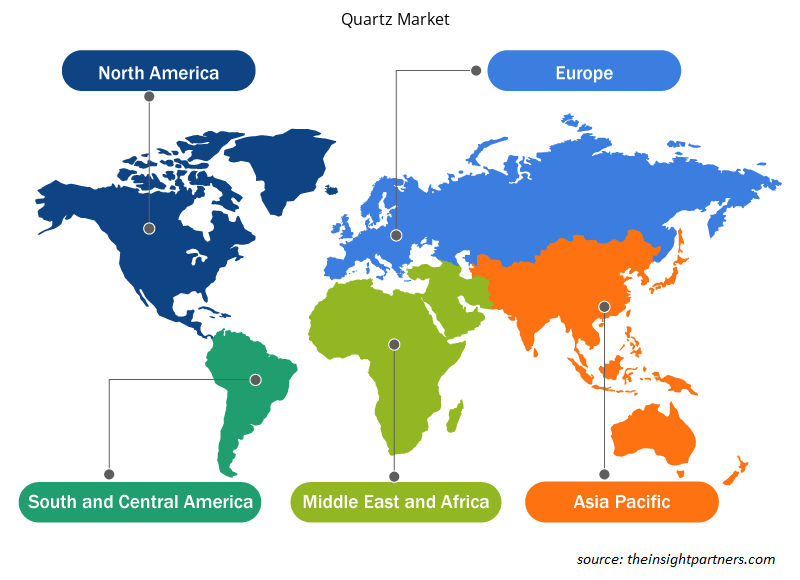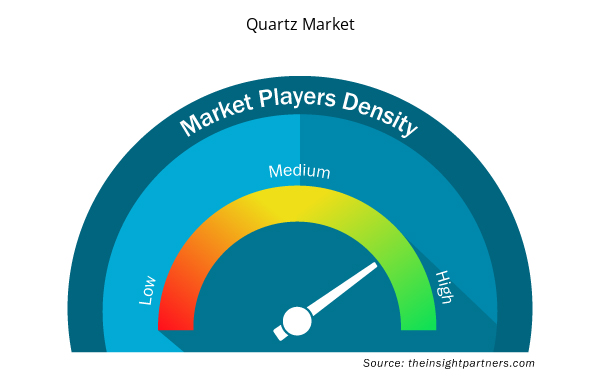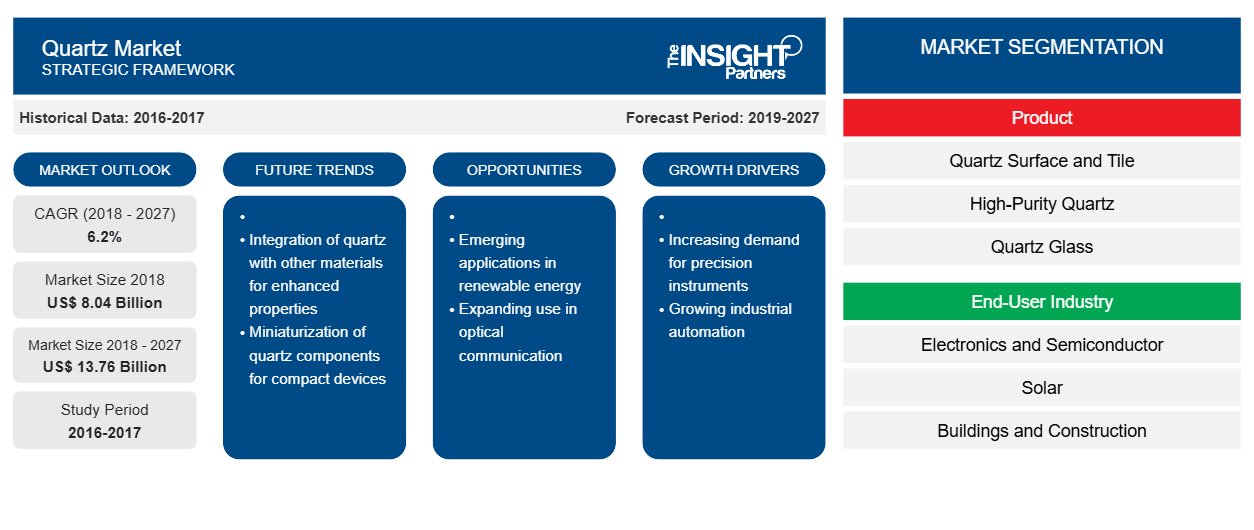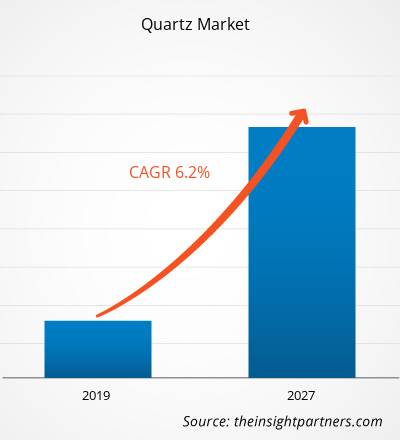2018 年石英市场规模为 80.37 亿美元,预计在 2019 年至 2027 年的预测期内,复合年增长率为6.2%,到 2027 年将达到 137.626 亿美元。
石英是一种在低温和低压下稳定的 SiO2 矿物形式。它主要存在于大陆地区的火成岩、沉积岩、变质岩和热液矿物环境中。它对机械和化学风化具有很强的抵抗力,高耐久性使其成为山顶的主要矿物以及河流、海滩和沙漠沙子的主要成分。
亚太地区在全球石英市场中占有最大的市场份额。该地区由Caesarstone、Hanwha L&C、Dupont Cosentino Group 等多家石英制造商主导,推动了石英市场的增长。这些参与者为了提高运营效率而迅速采用创新和先进技术,预计将在预测期内推动亚太地区石英市场的发展。工业发展的不断增加加上政府对汽车和电气电子基础设施的投资不断增加,预计将在未来几年推动石英市场的发展。此外,石英生产研发投资的增加预计将推动亚太地区石英市场的增长。印度、中国和日本是最大的国家,为亚太地区整个石英市场做出了贡献。
定制此报告以满足您的需求
您可以免费定制任何报告,包括本报告的部分内容、国家级分析、Excel 数据包,以及为初创企业和大学提供优惠和折扣
- 获取此报告的关键市场趋势。这个免费样品将包括数据分析,从市场趋势到估计和预测。
市场洞察
石英的丰富供应和广泛的应用推动了石英市场的发展
石英在电子和半导体、太阳能、建筑和施工、医疗、光学和电信等行业中有着广泛的应用。石英天然具有不同的种类、形状、透明度和颜色,这进一步增加了它的价值和应用。不同类型的彩色石英被认为是半宝石,它们经常用于珠宝和石雕。紫水晶、紫黄晶、黄水晶和蛋白石是宝石或半宝石,因其颜色和耐用性而被广泛用于珠宝。将石英磨成石英砂后,它可用于生产玻璃纤维,并可用作喷砂和石材切割的磨料。纯石英砂广泛用于水净化系统。石英制成的小碎片用于手表、电视、钟表、计算机和立体声音响,因为石英在压力下有可能产生可以控制电脉冲频率的电压。
合成石英需求的不断增长预计将推动全球石英市场的发展
合成石英具有多种有益特性,例如耐酸、耐腐蚀、耐高温、耐冲击、耐磨损、耐压缩、耐弯曲和耐渗透。因此,它广泛应用于电子和半导体行业。合成石英最突出的应用是用于微光刻投影系统的波长激光器的光学元件。由合成石英制成的光学元件用于传输高能紫外激光辐射,以生产大规模集成电路。合成石英元件具有很强的抗激光能力,这使得它们适用于高功率或短波长激光器。合成石英还用于制造坩埚,用于拉制用于生产半导体器件和太阳能电池的单晶硅。高纯度石英还用于太阳能行业中从硅金属中提炼单晶锭。目前,光学仪器和电子元件中使用的大多数石英晶体都是在实验室中生产的,而不是从矿山中提取的。因此,合成石英的易得性和它在电子电气、汽车和建筑等各个行业的应用是推动合成石英需求和影响全球石英市场的因素之一。
产品洞察
根据产品,全球石英市场细分为石英表面和瓷砖、高纯石英、石英玻璃、石英晶体、石英砂等。在产品细分市场中,石英表面和瓷砖市场引领了全球石英市场。此外,预计高纯石英细分市场在预测期内的复合年增长率最快。高纯石英 (HPQ) 的杂质含量可忽略不计,二氧化硅含量超过 99%。HPQ 用于半导体、太阳能、光纤和照明等行业。高纯熔融石英由高纯石英制成,具有制造各种高科技产品所必需的各种光学、机械和热性能。半导体行业对高纯石英的需求不断增长是推动全球高纯石英需求的主要因素。在半导体行业,HPQ 用于生产管、坩埚和棒等应用。
最终用户行业洞察
全球石英市场按终端用户行业细分为电子和半导体、太阳能、建筑和建筑、医疗、光学和电信等。电子和半导体领域在全球石英市场中占有最大份额。石英广泛用于谐振器等电子设备,以提供稳定的性能。天然纯石英用于半导体工业中硅晶片的生长。纯石英砂用于生产晶体管的硅金属半导体,用于集成电路、微电子和硅芯片的开发。石英还用作压电电池,在施加应力时产生电能,甚至产生逆效应。
合并和收购被视为全球石英市场最常采用的策略。以下列出了全球石英市场的一些最新发展:
2019 年:圣戈班公司 (Saint Gobain SA) 对新可能的应用进行了研发。2017
年:Quality Quartz Engineering 被选中负责为世界上最大的聚变反应堆的能源供应提供承重石英棒的设计开发工作。
石英市场区域洞察
Insight Partners 的分析师已详细解释了预测期内影响石英市场的区域趋势和因素。本节还讨论了北美、欧洲、亚太地区、中东和非洲以及南美和中美洲的石英市场细分和地理位置。

- 获取石英市场的区域特定数据
石英市场报告范围
| 报告属性 | 细节 |
|---|---|
| 2018 年市场规模 | 80.4 亿美元 |
| 2027 年市场规模 | 137.6亿美元 |
| 全球复合年增长率(2018 - 2027) | 6.2% |
| 史料 | 2016-2017 |
| 预测期 | 2019-2027 |
| 涵盖的领域 | 按产品
|
| 覆盖地区和国家 | 北美
|
| 市场领导者和主要公司简介 |
|
石英市场参与者密度:了解其对商业动态的影响
石英市场正在快速增长,这得益于终端用户需求的不断增长,而这些需求又源于消费者偏好的不断变化、技术进步以及对产品优势的认识不断提高等因素。随着需求的增加,企业正在扩大其产品范围,进行创新以满足消费者的需求,并利用新兴趋势,从而进一步推动市场增长。
市场参与者密度是指在特定市场或行业内运营的企业或公司的分布情况。它表明在给定市场空间中,相对于其规模或总市场价值,有多少竞争对手(市场参与者)存在。
在石英市场运营的主要公司有:
- 凯撒石有限公司
- 赛默飞世尔科技公司
- 矽比科
- EI 杜邦德内穆尔公司
- 圣戈班集团
免责声明:上面列出的公司没有按照任何特定顺序排列。

- 获取石英市场顶级关键参与者概览
全球石英市场细分
全球石英市场 - 按产品分类
- 石英表面和瓷砖
- 高纯石英
- 石英玻璃
- 石英晶体
- 石英砂
- 其他的
全球石英市场 - 按最终用户行业
- 电子和半导体
- 太阳的
- 建筑和施工
- 医疗的
- 光学与电信
- 其他的
全球石英市场 - 按地区划分
北美
- 我们
- 加拿大
- 墨西哥
欧洲
- 德国
- 法国
- 意大利
- 英国
- 俄罗斯
- 欧洲其他地区
亚太地区
- 澳大利亚
- 中国
- 印度
- 日本
- 韩国
- 亚太其他地区
中东和非洲 (MEA)
- 南非
- 沙特阿拉伯
- 阿联酋
- MEA 其他地区
南美洲
- 巴西
- 阿根廷
- 南美洲其他地区 (SAM)
公司简介
- 凯撒石有限公司
- 赛默飞世尔科技公司
- 矽比科
- EI 杜邦德内穆尔公司
- 圣戈班集团
- 克雷斯威克石英
- 石英公司
- 迈图高新材料有限公司
- 巴巴石英
- 优质石英工程
- 历史分析(2 年)、基准年、预测(7 年)及复合年增长率
- PEST 和 SWOT 分析
- 市场规模价值/数量 - 全球、区域、国家
- 行业和竞争格局
- Excel 数据集



Report Coverage
Revenue forecast, Company Analysis, Industry landscape, Growth factors, and Trends

Segment Covered
This text is related
to segments covered.

Regional Scope
North America, Europe, Asia Pacific, Middle East & Africa, South & Central America

Country Scope
This text is related
to country scope.
常见问题
Building and construction industry is expected to grow at a faster pace during the forecasted period. Increasing demand for quartz surfaces and tiles in residential and commercial sectors is projected to boost the demand for quartz from the building and construction industry. Moreover, quartz kitchen countertops are gaining popularity due to their durability and stain resistance properties. Due to the increasing popularity of quartz countertops, many American and European producers are innovating new products by mixing quartz material with different types of resin. Additionally, quartz is a cheaper alternative to natural stone, such as marble countertops and granite countertops. These factors are propelling the demand for quartz in the building and construction sector.
The major players operating in the global quartz market, includes Baba Quartz, Quality Quartz Engineering, Momentive, Quartz Corporation, Creswick Quartz, Saint Gobain S.A., Dupont, Sibelco NV, Thermofisher Scientific, and Caesarstone Ltd among others.
The quartz was dominated by the Asia Pacific at a global level. The largest market share of this region is primarily attributed to the presence of major quartz manufacturers in the region. Increasing demand for quartz from the electronics industry in developed and developing countries in the APAC countries such as China, Japan, South Korea, and India is propelling the growth of the quartz market in APAC. Furthermore, the well-established building and construction sector in the Asian countries provides a huge market opportunity for the key players operating in the quartz market. The quartz and quartz products produced in Asian countries, such as China and India, are mainly exported to the US, Germany, and France. This further provides a huge customer base for quartz products manufactured in APAC.
Trends and growth analysis reports related to Chemicals and Materials : READ MORE..
The List of Companies - Global Quartz Market
- Caesarstone Ltd
- Thermo Fisher Scientific Inc.
- Sibelco
- E. I. DU Pont De Nemours and Company
- Saint Gobain S.A.
- Creswick Quartz
- Quartz Corporation
- Momentive Performance Materials Inc.
- Baba Quartz
- Quality Quartz Engineering
The Insight Partners performs research in 4 major stages: Data Collection & Secondary Research, Primary Research, Data Analysis and Data Triangulation & Final Review.
- Data Collection and Secondary Research:
As a market research and consulting firm operating from a decade, we have published and advised several client across the globe. First step for any study will start with an assessment of currently available data and insights from existing reports. Further, historical and current market information is collected from Investor Presentations, Annual Reports, SEC Filings, etc., and other information related to company’s performance and market positioning are gathered from Paid Databases (Factiva, Hoovers, and Reuters) and various other publications available in public domain.
Several associations trade associates, technical forums, institutes, societies and organization are accessed to gain technical as well as market related insights through their publications such as research papers, blogs and press releases related to the studies are referred to get cues about the market. Further, white papers, journals, magazines, and other news articles published in last 3 years are scrutinized and analyzed to understand the current market trends.
- Primary Research:
The primarily interview analysis comprise of data obtained from industry participants interview and answers to survey questions gathered by in-house primary team.
For primary research, interviews are conducted with industry experts/CEOs/Marketing Managers/VPs/Subject Matter Experts from both demand and supply side to get a 360-degree view of the market. The primary team conducts several interviews based on the complexity of the markets to understand the various market trends and dynamics which makes research more credible and precise.
A typical research interview fulfils the following functions:
- Provides first-hand information on the market size, market trends, growth trends, competitive landscape, and outlook
- Validates and strengthens in-house secondary research findings
- Develops the analysis team’s expertise and market understanding
Primary research involves email interactions and telephone interviews for each market, category, segment, and sub-segment across geographies. The participants who typically take part in such a process include, but are not limited to:
- Industry participants: VPs, business development managers, market intelligence managers and national sales managers
- Outside experts: Valuation experts, research analysts and key opinion leaders specializing in the electronics and semiconductor industry.
Below is the breakup of our primary respondents by company, designation, and region:

Once we receive the confirmation from primary research sources or primary respondents, we finalize the base year market estimation and forecast the data as per the macroeconomic and microeconomic factors assessed during data collection.
- Data Analysis:
Once data is validated through both secondary as well as primary respondents, we finalize the market estimations by hypothesis formulation and factor analysis at regional and country level.
- Macro-Economic Factor Analysis:
We analyse macroeconomic indicators such the gross domestic product (GDP), increase in the demand for goods and services across industries, technological advancement, regional economic growth, governmental policies, the influence of COVID-19, PEST analysis, and other aspects. This analysis aids in setting benchmarks for various nations/regions and approximating market splits. Additionally, the general trend of the aforementioned components aid in determining the market's development possibilities.
- Country Level Data:
Various factors that are especially aligned to the country are taken into account to determine the market size for a certain area and country, including the presence of vendors, such as headquarters and offices, the country's GDP, demand patterns, and industry growth. To comprehend the market dynamics for the nation, a number of growth variables, inhibitors, application areas, and current market trends are researched. The aforementioned elements aid in determining the country's overall market's growth potential.
- Company Profile:
The “Table of Contents” is formulated by listing and analyzing more than 25 - 30 companies operating in the market ecosystem across geographies. However, we profile only 10 companies as a standard practice in our syndicate reports. These 10 companies comprise leading, emerging, and regional players. Nonetheless, our analysis is not restricted to the 10 listed companies, we also analyze other companies present in the market to develop a holistic view and understand the prevailing trends. The “Company Profiles” section in the report covers key facts, business description, products & services, financial information, SWOT analysis, and key developments. The financial information presented is extracted from the annual reports and official documents of the publicly listed companies. Upon collecting the information for the sections of respective companies, we verify them via various primary sources and then compile the data in respective company profiles. The company level information helps us in deriving the base number as well as in forecasting the market size.
- Developing Base Number:
Aggregation of sales statistics (2020-2022) and macro-economic factor, and other secondary and primary research insights are utilized to arrive at base number and related market shares for 2022. The data gaps are identified in this step and relevant market data is analyzed, collected from paid primary interviews or databases. On finalizing the base year market size, forecasts are developed on the basis of macro-economic, industry and market growth factors and company level analysis.
- Data Triangulation and Final Review:
The market findings and base year market size calculations are validated from supply as well as demand side. Demand side validations are based on macro-economic factor analysis and benchmarks for respective regions and countries. In case of supply side validations, revenues of major companies are estimated (in case not available) based on industry benchmark, approximate number of employees, product portfolio, and primary interviews revenues are gathered. Further revenue from target product/service segment is assessed to avoid overshooting of market statistics. In case of heavy deviations between supply and demand side values, all thes steps are repeated to achieve synchronization.
We follow an iterative model, wherein we share our research findings with Subject Matter Experts (SME’s) and Key Opinion Leaders (KOLs) until consensus view of the market is not formulated – this model negates any drastic deviation in the opinions of experts. Only validated and universally acceptable research findings are quoted in our reports.
We have important check points that we use to validate our research findings – which we call – data triangulation, where we validate the information, we generate from secondary sources with primary interviews and then we re-validate with our internal data bases and Subject matter experts. This comprehensive model enables us to deliver high quality, reliable data in shortest possible time.


 获取此报告的免费样本
获取此报告的免费样本